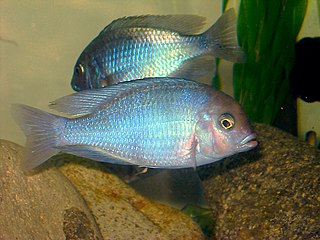
Cyrtocara moorii, commonly known as the hump-head, is a species of haplochromine cichlid endemic to Lake Malawi in east Africa where they prefer areas with sandy substrates. It can grow to a length of 20 centimetres (7.9 in) TL. The species is popular among aquarium keepers where it is known as the hump-head cichlid, blue dolphin cichlid, Malawi dolphin or simply as moorii. It is currently the only known member of its genus. The specific name honours the English cytologist and biologist John Edmund Sharrock Moore (1870-1947).

Nimbochromis livingstonii, Livingston's cichlid or (locally) kalingono, is a freshwater mouthbrooding cichlid native to Lake Malawi, an African Rift Lake. It is also found in the upper Shire River and Lake Malombe. They are found in inshore areas of the lake over sandy substrates.

Parachromis friedrichsthalii, the Yellowjacket cichlid, is a species of cichlid native to Central America where it is found along the Atlantic Slope in Mexico, Belize, Honduras and Guatemala. This species grows to a length of 28 centimetres (11 in) SL. This species is popular with anglers as a gamefish and can also be found in the aquarium trade. The specific name honours the Austrian explorer, botanist and archaeologist Emanuel von Friedrichsthal (1809-1842), who sent many specimens to Vienna from Central America, including the type of this fish.
Diplotaxodon ecclesi is a species of haplochromine cichlid. It is endemic to Lake Malawi where it is found in open water at mainly at the deeper levels, although it is rarely caught by trawling. Its main prey is the Lake Malawi sardine.

Docimodus johnstoni is a species of haplochromine cichlid. It is known from Lake Malawi, Lake Malombe, and the upper Shire River in Malawi, Mozambique, and Tanzania. This species has unusual feeding habits: it is reported to feed on fins of clariid catfishes. The specific name honours the British explorer, botanist, linguist and Colonial administrator, Sir Henry Hamilton Johnston, who presented the type to the British Museum.
Iodotropheus stuartgranti is a species of cichlid endemic to Lake Malawi. It can also be found in the aquarium trade. This species can reach a length of 10 centimetres (3.9 in) TL. The specific name honours Stuart M. Grant (1937-2007), an exporter of cichlids from lake Malawi for the aquarium trade. This species feeds maonly on aufwuchs. The males are territorial and the female will lay anywhere within a male's territory.

The scrapermouth mbuna is a species of cichlid endemic to Lake Malawi where it prefers areas with rocky substrates. This species can reach a length of 11.7 centimetres (4.6 in) TL. This species can also be found in the aquarium trade. Its specific name honours the British ichthyologist Ethelwynn Trewavas (1900-1993) of the British Museum.
Lethrinops stridei is a species of cichlid endemic to Lake Malawi where it occurs at depths of from 15 to 55 metres in areas with sandy substrates. This species grows to a length of 13 centimetres (5.1 in) SL. The specific name honours Kenneth E. Stride, who introduced successful commercial trawling to Lake Malawi, and this species is now very rare in Lake Malawi and is threatened by overfishing by commercial trawlers.
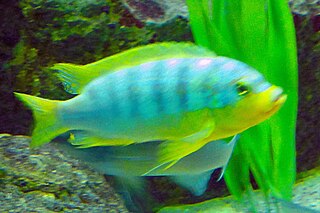
William's mbuna, also known as ice blue zebra mbuna or ice blue zebra or the Pseudotropheus ice blue among the aquarium enthusiasts, is a species of cichlid fish endemic to Lake Malawi where it is only found at Makokola in the southeastern arm of the lake. This species can reach a length of 13.4 centimetres (5.3 in) TL. It can also be found in the aquarium trade. The specific name honours the German ornamental fish importer Alfons Greshake.
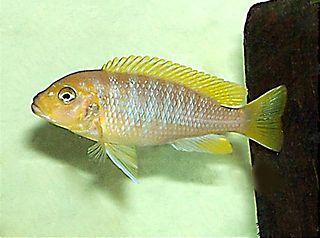
Maylandia hajomaylandi is a species of cichlid endemic to Lake Malawi where it is only known from around Chisumulu Island. This species can reach a length of 12 centimetres (4.7 in) TL. It can also be found in the aquarium trade. The specific name honours the cichlid enthusiast and author about aquaria Hans Joachim Mayland, who died in 2004,
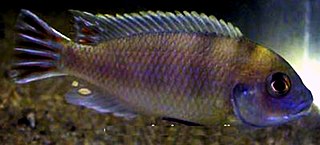
Maylandia livingstonii is a species of cichlid native to Lake Malawi and Lake Malombe. This species can reach a length of 15 centimetres (5.9 in) TL. It can also be found in the aquarium trade. The specific name of this fish honours the Scottish explorer and missionary David Livingstone (1813-1873).

Melanochromis loriae is a species of cichlid in the Cichlidae endemic to Lake Malawi. This species can reach a length of 12.5 centimetres (4.9 in) TL.
Mylochromis guentheri is a species of cichlid endemic to Lake Malawi where it is found over sandy substrates. This species can reach a length of 20 centimetres (7.9 in) TL. This species can also be found in the aquarium trade. The specific name honours the German-born British zoologist, ichthyologist, and herpetologist Albert Günther (1830-1914).
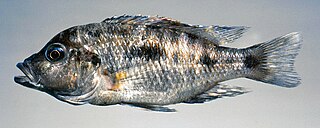
Otopharynx brooksi is a species of cichlid endemic to Lake Malawi. This species can reach a length of 15 centimetres (5.9 in) TL. This species can also be found in the aquarium trade. The specific name of this fish honours John Langdon Brooks (1920-2000), an evolutionary biologist at Yale University.
Pallidochromis tokolosh is species of cichlid endemic to Lake Malawi where it is only known from deep waters. This species is piscivorous and can reach a length of 28 centimetres (11 in) SL. It is the only known member of its genus. The specific name refers to the tokoloshe, the name of an evil water spirit in many central African languages, and is an allusion to the bulging eyes, long snout and pot belly of this species when trawled from the great depths and which has inspired many carvings which are sold around the Lake.
The Super VC-10 hap is a species of cichlid endemic to Lake Malawi along the Malawian shores of the lake. It prefers areas with rocky substrates. This species can reach a length of 18.7 centimetres (7.4 in) SL. It can also be found in the aquarium trade. In the wild uses its thickened lips to scrape algae from rocks and this seems to thicken the lips further, which tends not to be the case with aquarium specimens which have only slightly thickened lips.

The pindani is a species of cichlid endemic to Lake Malawi preferring areas with sandy substrates and nearby rocks where the males establish their territories. This species can reach a length of 6.7 centimetres (2.6 in) SL. It can also be found in the aquarium trade. The specific name of this fish honours the aquarium fish trader Ross Socolof (1925-2009).

The red top williamsi is a species of cichlid endemic to Lake Malawi where it occurs in areas with rocky substrates usually at depths of less than 2 metres (6.6 ft). This species can reach a length of 16.5 centimetres (6.5 in) TL. It can also be found in the aquarium trade. The specific name honours the Anglican missionary Joseph A. Williams who died by drowning in Lake Malawi in 1895, with Bishop Chauncy Maples, and who collected the type of the cichlid among others.
Rhamphochromis woodi is a species of piscivorous cichlid endemic to Lake Malawi where it prefers open waters at depths of from 8 to 121 metres. This species can reach a length of 42 centimetres (17 in) TL. It can also be found in the aquarium trade. The specific name honours Rodney C. Wood, whose collection of cichlids from Lake Malawi, which included the type of this species, was presented to the British Museum.

Stigmatochromis woodi is a species of cichlid endemic to Lake Malawi where it can be found hunting for prey over sandy areas. It can reach a length of 25 centimetres (9.8 in) TL. It can also be found in the aquarium trade. The specific name honours Rodney C. Wood, whose collection of cichlids from Lake Malawi, which included the type of this species, was presented to the British Museum. It is the type species of the genus Stigmatochromis.














